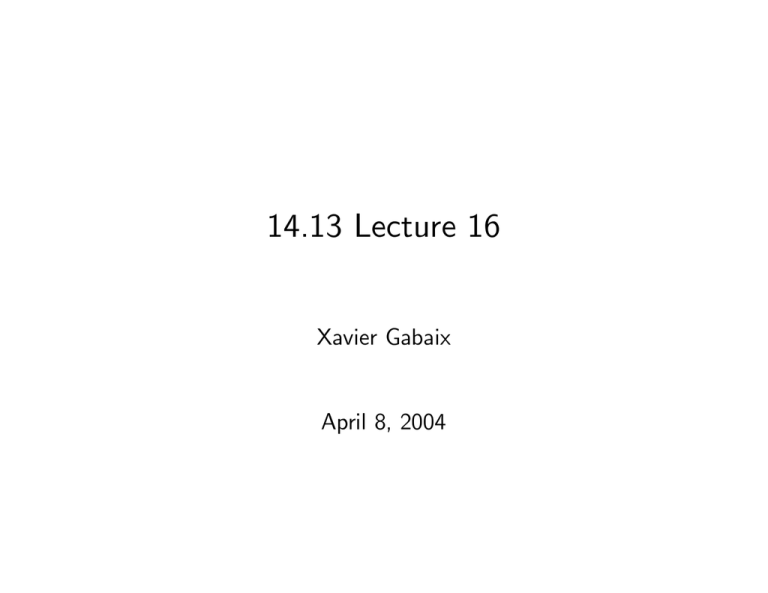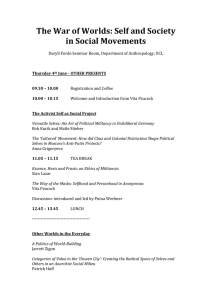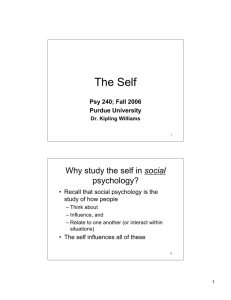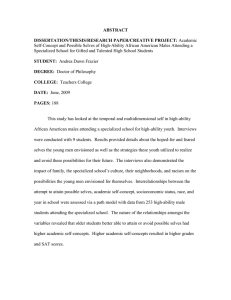14.13 Lecture 16 Xavier Gabaix April 8, 2004
advertisement

14.13 Lecture 16 Xavier Gabaix April 8, 2004 1 Is exponential discounting (and hence dynamic consistency) a good assumption? The property of dynamic consistency is appealing. • Early selves and late selves agree! — selft=0 decides C0 and plans for C1, C2... — selft=1 decides C1 and plans for C2, C3... • Can simply maximize at beginning of problem without worrying about later selves overturning the decisions of early selves. But, sometimes there does appear to be a conflict between early selves and late selves: — I’ll quit smoking next week... — I’ll start the problem set early, so I won’t need to work all night... — I’ll go to sleep now, but get up early so I can finish the problem set... — I’ll exercise this weekend... — I’ll eat better food... — I’ll call my grandparents next week... — I’ll start studying for my finals at the beginning of reading period.... — I’ll stop procrastinating on my term paper... Early selves say “be good” (get up at 7 to finish problem set) Late selves want “instant gratification” (keep hitting snooze button) When discount functions are not exponential, the intertemporal choice model generates a conflict between early selves and late selves: dynamic inconsistency. Dynamically inconsistent model predicts “self-control problems” like procrastination, laziness, addiction, etc... Motivation for dynamically inconsistent preferences: Measured discount functions don’t appear to be exponential. Instead, short-run discount rates are measured to be higher than long-run discount rates. Early selves want later selves to be patient. patient. Later selves don’t want to be ln ∆(t) exponential preferences ∆(1)/ ∆(0) = ∆(2)/ ∆(1) immediate gratifications ∆(1)/ ∆(0) < ∆(2)/ ∆(1) time 2 Discounting evidence Thaler (1981) • What amount makes you indifferent between $15 today and $X in 1 month? (X = 20) If your preferences were exponential, the initial utility is V0 = X δ tu(ct) t where t is expressed in years. Call V 0 the utility from accepting $15 today and V 00 the utility form accepting $X in 1 month V 0 − V0 = u(c0 + 15) − u(c0) V 00 − V0 = δ t (u(ct + X) − u(ct)) You are indifferent iff V 0 − V0 = V 00 − V0 ⇐⇒ u(c0 + 15) − u(c0) = δ t (u(ct + X) − u(ct)) ⇐⇒ 15u0(c0) = δ tX u0(ct) by Taylor expansion as 15 ¿ c0 and X ¿ ct. Assume now that c0 ' ct ⇐⇒ 15 = δ tX 1 X ⇐⇒ − ln δ = ln t 15 • What is a "reasonable" δ? — Economists will say that at a yearly horizon, δ ' 0.95. — Why? People solve max c 1 =W c0+ 1+r u(c0) + δu(c1) µ c L = u(c0) + δu(c1) − λ c0 + 1 1+r ¶ ∂L = 0 ∂c0 ∂L = 0 ∂c1 ( 0 ⇔ u (c0) − λ = 0 λ =0 δu0(c1) − 1+r ⇒ u0(c0) = δ(1 + r)u0(c1) which is the Euler’s equation One can observe that at the macroeconomic level c0 ' c1 which implies 1 δ(1 + r) = 1 ⇒ δ = ' 1 − r = 0.95 1+r where the equilibrium level of the interest rate is r = 5% per year. • At the microeconomic level 1 ln X/15 t 1 = ln 20/15 1/12 = 345% per year − ln δ = • Why? — different attitudes towards small amounts and large amounts — borrowing constraints • What makes you indifferent between $15 today and $X in ten years? (X = 100) 1 − ln δ = ln X/15 τ 1 = ln X/15 10 = 19% per year Benzion, Rapoport and Yagil (1989) • What amount makes you indifferent between $40 today and $X in half a year? (X = 50) 40 = Xδ τ so 1 ln X/40 τ 1 = ln X/40 .5 = 45% per year − ln δ = • What makes you indifferent between $40 today and $X in four years? (X = 90) 1 − ln δ = ln X/40 τ 1 = ln X/40 4 = 20% per year • In most experiments, shifting out both rewards by the same amount of time lowers the implied discount rate (e.g., Kirby and Herrnstein, Psychological Science, 1996). • For example, $45 right now is preferred to $52 in 27 days. 1 − ln δ > ln 52/45 27/365 = 195% per year • But, $45 in six days is inferior to $52 in 33 days (now − ln δ < 195% per year). • With exponential discounting, no preference reversal i.e. if X now > Y in ∆t, then X at t > Y at t + ∆t. Indeed — X now > Y in ∆t ⇔ X ≥ δ ∆tY — X at t > Y at t + ∆t ⇔ δ tX ≥ δ t+∆tY — here X = $45, Y = $52, ∆t = 27days and t = 6days. Vast body of experimental evidence, demonstrates that discount rates are higher in the short-run than in the long-run. Consider a final thought experiment: • Choose a ten minute break today or a fifteen minute break tomorrow. • Choose a ten minute break in 100 days or a fifteen minute break in 101 days. • If V = P ∆(t)u(ct), what is ∆(t) — big reward: UB — small reward: US — t1 = 1 day, t = 100 days US ∆(0) > UB ∆(t1) US ∆(t) < UB ∆(t + t1) ) ⇒ ∆(t1) ∆(t + t1) U < S < ∆(0) UB ∆(t) minus 1 and divide by t1 both sides ⇒ ∆(t1)−∆(0) t1 ∆(0) ∆0(0) ∆0(t) when t1 −→ 0, < ∆(0) ∆(t) < ∆(t+t1)−∆(t) t1 ∆(t) (1) Rewrite the discounting function as ∆(t) = e− Rt 0 ρ(s)ds where ρ is the discount rate or the rate of time discounting (it measures the impatience), the higher ρ the more impatient. Note that with exponential preferences ρ(s) = − ln δ as ∆(t) = et ln δ . Generalize (1) for t > τ > 0 ∆0(0) ∆0(τ ) ∆0(t) < < ∆(0) ∆(τ ) ∆(t) ∆0(t) and note that ∆(t) = −ρ(t) ⇒ ρ(0) > ρ(τ ) > ρ(t) i.e. ρ is decreasing





